Guest post by Julie Allan, BFA candidate, Savannah College of Art and Design
The Telfair Academy: The Vision of Mary Telfair
Located in Savannah’s historic district, The Telfair Academy displays the American past in art, architecture and historic preservation of sites. The vision for the Museum was born in the heart of Mary Telfair (Fig. 1). A woman with a deep passion for intellect and culture, Mary was also an heiress to a fortune. Her legacy was to leave her home, art collection and remaining fortune to create the Telfair Academy of Arts and Sciences, the first public art museum in the South.
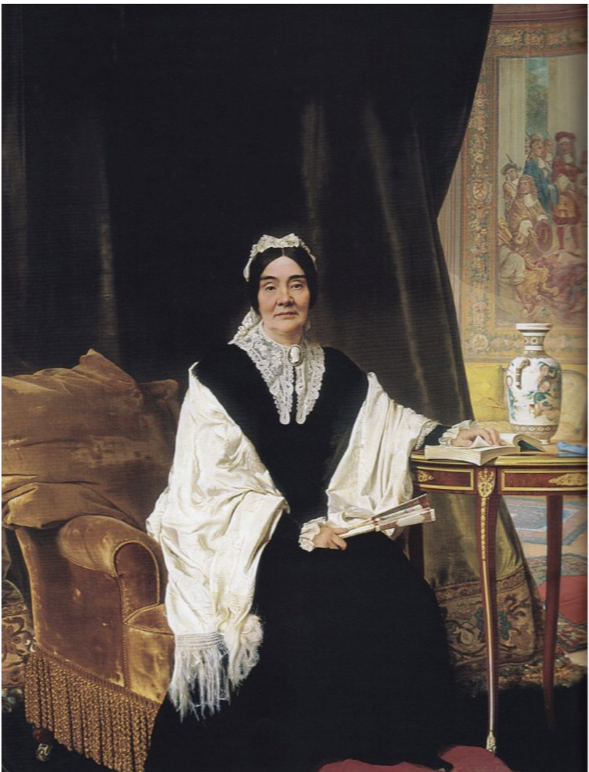
The Telfair Academy, one of three Telfair Museums in Savannah, houses a permanent collection of paintings, sculpture, decorative art and two nineteenth-century showrooms with furniture and decorations. The museum also holds temporary exhibitions in the many upper-level galleries. Currently on view at the Academy are four women artists who, much like Mary, left an amazing legacy to their hometown of Savannah.
Emma Cheves Wilkins (1870–1967)
Emma Cheves Wilkins was a traditionally trained artist. Both her mother and grandmother had been academically trained as artists as well, so it was no surprise that after graduating from boarding school in Baltimore, Emma went to Paris to study art at the Académie Colarossi. There she developed her command of color and form, of which Playing with Reds (Fig. 2), one of her many still life color studies, is a good example.
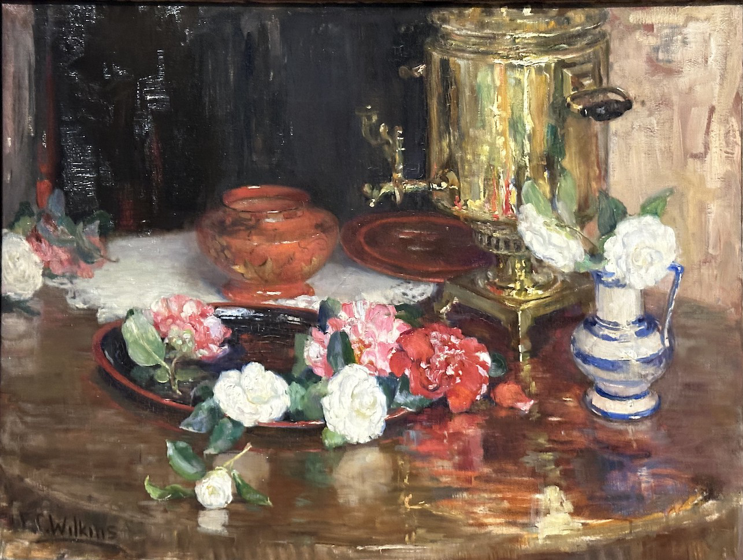
Disapproving of the recent movements where artists used unconventional colors and abstractions, she kept her work traditional, painting landscapes and still lifes. The loose impressionistic style of her landscapes, evident in her painting Iron Gate at Bonaventure (Fig. 3), reflects her time in Paris.
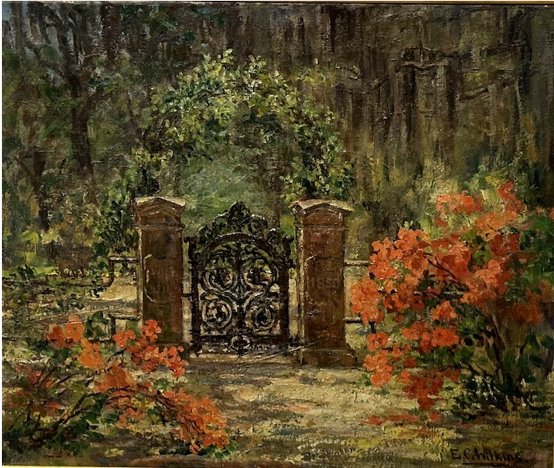
She dedicated her life to art, education and history, keeping records and creating a census of Southern paintings that is now in the Frick Art Reference Library in New York City. She pursued a serious career in art as the attitude towards femininity started to change with the turn of the century, and became a self-sustaining artist, dedicating her life to her craft. She taught many artists of the next generation in Savannah, including Myrtle Jones and Augusta Oelschig, two of the other artists highlighted here.
Anna Colquitt Hunter (1892–1985)
If Emma’s route toward art was traditional, Anna’s was absolutely the opposite. Living in Savannah from a young age, Anna was raised as a classically Southern girl. She left college to get married and have children. But the usual and familiar path she expected for her life was disrupted by the untimely death of her husband. With three children to support, Anna procured a job at the local newspaper, where she became an editor and writer for the society page. Although she was in her fifties, she served as a field director in the American Red Cross during World War II. After the war she went to work as a literary, dramatic, and visual arts critic for the Savannah Morning News. But having little experience with the subject, she decided the best way to acquire knowledge would be to teach herself to paint.

She did also take classes in theater and a children’s art course course at the Telfair Academy, but it was her own pursuit of painting (of which Fig. 4 is an example) that truly familiarized her with the arts.
Her greatest achievement, however, was an initiative that completely changed the city of Savannah. The then decaying city suffered from a lack of preservation of its historic sites—all over town the once beautiful buildings were left forgotten. Among those was the building that housed the Historic Savannah Foundation (HSF). Anna gathered a group of six other ladies and organized an effort to save the Foundation. Her efforts would extend ultimately to saving the entire city, by restoring and preserving historic buildings that were at risk of being lost to decay and lack of care.
Myrtle Jones (1913–2005)
Although she was not native to Savannah, no one born there could love it more than Myrtle Jones did. “No matter where I go—North, South, East or West—I always come back to Savannah where I’ve been painting for 45 years.” This is how Myrtle introduced her book A Savannah Experience, where she recalls her life story and accomplishments. As a lady looking for happiness and companionship, she quickly settled into an unhappy marriage as she moved from Winder, a small town just outside of Atlanta, to Savannah in hopes of starting a new life. But she soon left her alcoholic husband to live on her own in a house on Gaston Street, which she turned into her studio. (Fig.5)

Quickly rising to the status of a serious well-known self-sustaining artist, Myrtle took classes at the Telfair Academy, although she considered herself to be mostly self-taught. Once she immersed herself in the arts, her newfound passion for the city of Savannah was reflected in her work. The squares, old houses and quaint cottages enchanted her as her eyes were opened to the beauty and color of the world around her. Developing sketches of the city and of daily life in Savannah, her art style was composed of loose strokes and harmonious soft colors (Fig. 6).
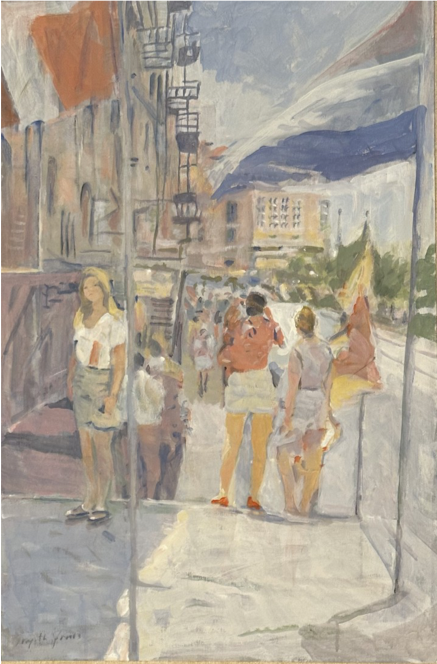
Her talent and success brought her recognition locally and eventually even in the big city, Atlanta. An article titled “You should know her” in the Savannah Morning News highlighted Myrtle’s work and introduced her studio to the public.
Augusta Oelschig (1918–2000)
Born and raised in Savannah, Augusta Oelschig started her artistic journey with art lessons at the Savannah public schools, and later in private lessons with Emma Cheves Wilkins. Her controversial choices of subject matter met with some resistance in the cultural atmosphere of the Southern city of Savannah. Her work stood out for her social commentary and unique style portraying African American scenes and Southern culture (Fig. 7).
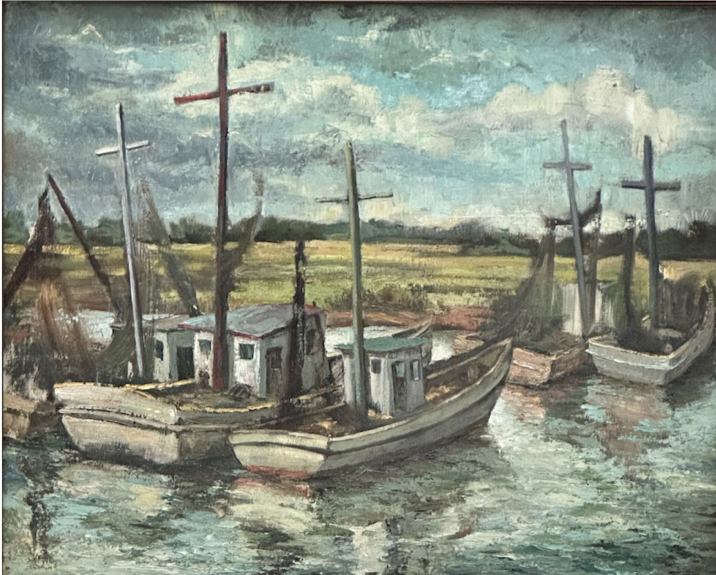
During a trip to Mexico she met muralists Diego Rivera and Jose Clemente Orozco; this proved to have a deep influence in her work. She intended to create a mural that illustrated the recent history of Savannah. In the drafts she included intense images of the Ku Klux Klan members whipping African Americans and also a reference to a politician who was later endorsed by the Klan. The atmosphere at the time was conservative and people were shocked at Oelschig’s controversial mural design, so the school administrators rejected the proposal.
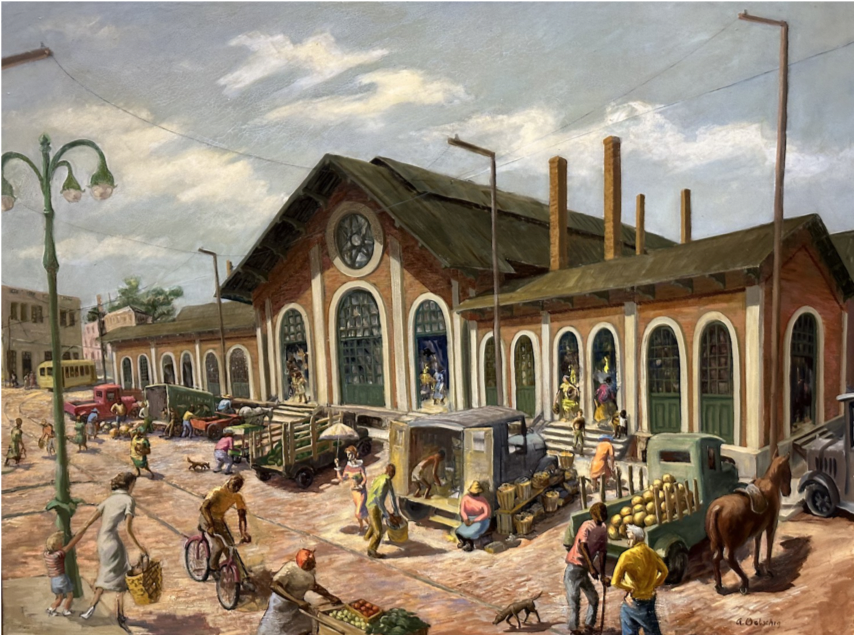
After this, she moved to New York in hopes of finding a place that would welcome her progressive ideas. Although the prominent art movement in New York was abstract, she stuck with her personal style and focused on African American and Southern culture topics in genre painting. This we can see in her artwork (displayed at the Telfair Academy) Old City Market (Fig. 8), in which she celebrates the once thriving old city market that is now no longer standing. But then, it was filled with life, the presence of shoppers, vendors, animals, produce and the movement of a Southern town market.
Conclusion
These four extraordinary women are only a few from the many artists, male and female, highlighted at the Telfair Academy. Mary Telfair’s vision lives on to bring us closer to the lives of successful and influential artists that lived right here in Savannah, showing their work alongside internationally acclaimed artists and in doing so, elevating and valuing local history.
Julie Allan studies illustration, writing and painting at the Savannah College of Art and Design. She is currently researching her first book, a novel narrating the Impressionist movement and the artists who started it. Graduating from her BFA she plans on pursuing a master’s degree in Classics, as she has a great interest in historical narrative, mythology, literature and archaeology. Follow her on Instagram.
Other Art Herstory blog posts you might enjoy:
Sculpture or Suffrage: Alice Morgan Wright, by Jennifer Dasal
Modern Women Artists in Copenhagen 2024–2025: Three Exhibitions, by Alice M. Rudy Price
Frida: Beyond the Myth at the Dallas Museum of Art, by Olivia Thomas
A Quiet Eye—The Unique Achievement of Sylvia Shaw Judson, by Rowena Loverance
Reflections on the Audacious Art Activist and Trailblazer Augusta Savage, by Sandy Rattler
Frida: Beyond the Myth at the Dallas Museum of Art, by Olivia Thomas
Deirdre Burnett: A Significant British Ceramic Artist Remembered, by Jo Lloyd
Nancy Sharp: An Undeservedly Forgotten Exemplar of Modern British Painting, by Christopher Fauske
Visual Feasts: The Art of Sarah Mapps Douglass, by Erika Piola
Illuminating Sarah Cole, by Kristen Marchetti
Defining Moments: Mary Cassatt and Helen McNicoll in 1913, by Julie Nash
Laura Seymour Hasbrouck, A Painter of the Hudson River School, by Lili Ott
Susie M. Barstow: Redefining the Hudson River School, by Nancy Siegel
Esther Pressoir: Imagining the Modern Woman, by Suzanne Scanlan
Dalla Husband’s Contribution to Atelier 17, by Silvano Levy
Happy Birthday, Fidelia Bridges! by Katherine Manthorne
Esther Pressoir: Imagining the Modern Woman, by Suzanne Scanlan
The Ongoing Revival of Matilda Browne, American Impressionist, by Alexandra Kiely
The Life and Art of Dorothea Tanning, by Victoria Carruthers





very interesting! These are stories that should be told by Savannah guides. excellent text, very well written
Good job!! Interesting article and very well written.